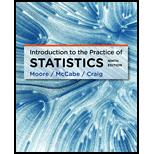
(a)
Section 1:
To find: The
(a)
Section 1:
Answer to Problem 58E
Solution: The
Explanation of Solution
Calculation: In order to test the difference in proportions for
Also, out of 349 customers (represented as
The difference between the two sample proportions
The Standard Error of
For
Hence, the margin of error is about
The
Hence, it can be said that with
Section 2:
To find: The
Section 2:
Answer to Problem 58E
Solution: The
Explanation of Solution
It is provided that out of 40 runners (represented as
Also, it is provided that out of 40 runners (represented as
The difference between the two sample proportions
The Standard Error of
For
Hence, the margin of error is about
The
Hence, it can be said that with
Section 3:
To explain: The concept of confidence interval based on above Sections 1 and 2.
Section 3:
Answer to Problem 58E
Solution: The difference in the proportion of male customers who tip a server wearing red colored shirt and the proportion of male customers who tip a server wearing a different colored shirt than red, with
Explanation of Solution
Given: In sections 1 and 2 above, the
Explanation: The confidence interval shows the bracket of values which are an estimate that the value of the parameter will lie between these values. The confidence interval obtained for part (a) is
Want to see more full solutions like this?
Chapter 8 Solutions
Introduction to the Practice of Statistics
 MATLAB: An Introduction with ApplicationsStatisticsISBN:9781119256830Author:Amos GilatPublisher:John Wiley & Sons Inc
MATLAB: An Introduction with ApplicationsStatisticsISBN:9781119256830Author:Amos GilatPublisher:John Wiley & Sons Inc Probability and Statistics for Engineering and th...StatisticsISBN:9781305251809Author:Jay L. DevorePublisher:Cengage Learning
Probability and Statistics for Engineering and th...StatisticsISBN:9781305251809Author:Jay L. DevorePublisher:Cengage Learning Statistics for The Behavioral Sciences (MindTap C...StatisticsISBN:9781305504912Author:Frederick J Gravetter, Larry B. WallnauPublisher:Cengage Learning
Statistics for The Behavioral Sciences (MindTap C...StatisticsISBN:9781305504912Author:Frederick J Gravetter, Larry B. WallnauPublisher:Cengage Learning Elementary Statistics: Picturing the World (7th E...StatisticsISBN:9780134683416Author:Ron Larson, Betsy FarberPublisher:PEARSON
Elementary Statistics: Picturing the World (7th E...StatisticsISBN:9780134683416Author:Ron Larson, Betsy FarberPublisher:PEARSON The Basic Practice of StatisticsStatisticsISBN:9781319042578Author:David S. Moore, William I. Notz, Michael A. FlignerPublisher:W. H. Freeman
The Basic Practice of StatisticsStatisticsISBN:9781319042578Author:David S. Moore, William I. Notz, Michael A. FlignerPublisher:W. H. Freeman Introduction to the Practice of StatisticsStatisticsISBN:9781319013387Author:David S. Moore, George P. McCabe, Bruce A. CraigPublisher:W. H. Freeman
Introduction to the Practice of StatisticsStatisticsISBN:9781319013387Author:David S. Moore, George P. McCabe, Bruce A. CraigPublisher:W. H. Freeman





